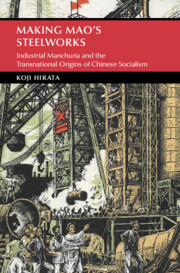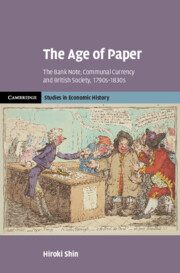Refine search
Actions for selected content:
26946 results in Economic history
2 - The Users of the Bank of England Note
-
- Book:
- The Age of Paper
- Published online:
- 19 December 2024
- Print publication:
- 02 January 2025, pp 67-107
-
- Chapter
- Export citation
Copyright page
-
- Book:
- The Age of Paper
- Published online:
- 19 December 2024
- Print publication:
- 02 January 2025, pp vi-vi
-
- Chapter
- Export citation
Introduction
-
- Book:
- The Age of Paper
- Published online:
- 19 December 2024
- Print publication:
- 02 January 2025, pp 1-27
-
- Chapter
- Export citation
Conclusion
-
- Book:
- The Age of Paper
- Published online:
- 19 December 2024
- Print publication:
- 02 January 2025, pp 270-277
-
- Chapter
- Export citation
Bibliography
-
- Book:
- The Age of Paper
- Published online:
- 19 December 2024
- Print publication:
- 02 January 2025, pp 278-311
-
- Chapter
- Export citation
5 - The Forgery Crisis and the Radicalisation of Communal Currency
-
- Book:
- The Age of Paper
- Published online:
- 19 December 2024
- Print publication:
- 02 January 2025, pp 191-234
-
- Chapter
- Export citation
Acknowledgements
-
- Book:
- The Age of Paper
- Published online:
- 19 December 2024
- Print publication:
- 02 January 2025, pp x-xii
-
- Chapter
- Export citation
Hedges of the Second Republic: firms, equity investors and political uncertainty in a nascent democracy, 1930–1936
-
- Journal:
- Revista de Historia Economica - Journal of Iberian and Latin American Economic History / Volume 43 / Issue 1 / March 2025
- Published online by Cambridge University Press:
- 02 January 2025, pp. 33-62
- Print publication:
- March 2025
-
- Article
-
- You have access
- Open access
- HTML
- Export citation
Figures and Illustrations
-
- Book:
- The Age of Paper
- Published online:
- 19 December 2024
- Print publication:
- 02 January 2025, pp viii-viii
-
- Chapter
- Export citation
6 - Resumption and Its Aftermath
-
- Book:
- The Age of Paper
- Published online:
- 19 December 2024
- Print publication:
- 02 January 2025, pp 235-269
-
- Chapter
- Export citation

There Will Be the Devil to Pay
- Central Bankers, Uncertainty and Sensemaking in the European Financial Crisis of 1931
-
- Published online:
- 21 December 2024
- Print publication:
- 09 January 2025

Atlas of Material Life
- Northwestern Europe and East Asia, Fifteenth to Nineteenth Century
-
- Published by:
- Amsterdam University Press
- Published online:
- 19 December 2024
- Print publication:
- 12 March 2020
-
- Book
- Export citation

Making Mao's Steelworks
- Industrial Manchuria and the Transnational Origins of Chinese Socialism
-
- Published online:
- 19 December 2024
- Print publication:
- 05 December 2024

The Age of Paper
- The Bank Note, Communal Currency and British Society, 1790s–1830s
-
- Published online:
- 19 December 2024
- Print publication:
- 02 January 2025

Plebeian Consumers
- Global Connections, Local Trade, and Foreign Goods in Nineteenth-Century Colombia
-
- Published online:
- 18 December 2024
- Print publication:
- 05 December 2024
Bibliography
-
- Book:
- Money, Value, and the State
- Published online:
- 05 December 2024
- Print publication:
- 12 December 2024, pp 329-355
-
- Chapter
- Export citation
Conclusion
-
- Book:
- Money, Value, and the State
- Published online:
- 05 December 2024
- Print publication:
- 12 December 2024, pp 304-326
-
- Chapter
- Export citation
Index
-
- Book:
- Money, Value, and the State
- Published online:
- 05 December 2024
- Print publication:
- 12 December 2024, pp 356-360
-
- Chapter
- Export citation
1 - The Moneychanger State
-
- Book:
- Money, Value, and the State
- Published online:
- 05 December 2024
- Print publication:
- 12 December 2024, pp 51-91
-
- Chapter
- Export citation
Acknowledgments
-
- Book:
- Money, Value, and the State
- Published online:
- 05 December 2024
- Print publication:
- 12 December 2024, pp x-xiv
-
- Chapter
- Export citation
